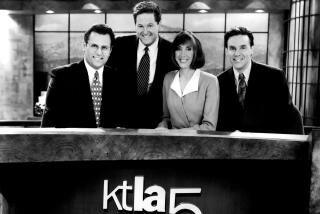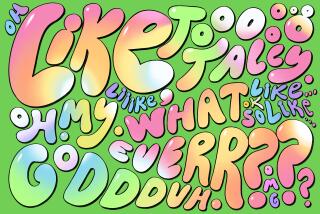Let’s Hear It for Dialects on Television
- Share via
What’s best about “Jerry Springer”--an otherwise ordinary and look-alike syndicated talk series now airing at 11 a.m. weekdays on KCAL Channel 9--is that it originates in Cincinnati.
True, no one has ever called Cincinnati the Paris of the Midwest. Or even the Kansas City of the Midwest. It may not even be the pearl of Ohio. The point is, however, that this river city dances almost cheek to cheek with Kentucky, the result often being that some members of Springer’s studio audience hail from a place where many people talk, you know, dif’frent.
That is, different from most everyone else you hear on national television.
Springer’s “Donahue”-style series reeks of staleness (when I tuned in most recently, he and some of his guests had discovered transvestites). But what I find refreshing are the dialects (not all Kentuckians speak the same) of some of the questioners in the studio audience, these melodic language rhythms taking me back to my days at the Louisville (pronounced “Louvul”) Times.
“Jerry Springer” is a barely visible blip. In being at once derivative and distinctively regional, however, this obscure Cincinnati talk show becomes a metaphor for what television is and isn’t.
As much as anything, TV promotes sameness, not only in programming but in the people it places before the camera and designates as surrogates for the entire nation. Television’s quest for pastel blandness can be relentless. Its decisionmakers, fearful that unfamiliar or allegedly discordant sounds make viewers squirm uncomfortably, forsake diversity and instead turn the medium into a great neutralizer or homogenizer. It creates its own electronic boot camp, a process of breaking down and blending with the purpose of creating uniformity.
Thus, in terms of language, almost everyone sounds alike.
There are some notable exceptions, headed by the Southern accents on “Designing Women” and, to a lesser extent, “Evening Shade,” “I’ll Fly Away” and “In the Heat of the Night,” the Yiddish talk on “Brooklyn Bridge” and Okie talk on “The Torkelsons.” On cable, moreover, the street-mouthing rappers on MTV and country crooners on the Nashville Network are a change of pace, and the fundamentalist Trinity Broadcasting Network often evangelizes through the distinctive populism of regional preachers.
There on the screen is good-ol-boy-talkin’ Kenneth Copeland, speaking from Ft. Worth, Tex., about the time years ago when he first set eyes on his wife and co-preacher, Gloria: “Ah mean, she flipped mah lid, right there!” Copeland’s sound flips my lid.
Most everywhere else on TV, the lid remains tightly screwed on, the richness of regional dialects having been rejected as unsuitable for national consumption.
Listen to the TV hosts and news anchors who speak to you daily, from morning shows to evening newscasts to late night. Maybe an expert in linguistics can detect the nuances and subtle differences. But to me, these people are soundalikes, their voices merging into a sort of language Muzak.
When I lived in Louisville, the ABC station there had a weathercaster who was just smashing. Knocked your socks off. Great personality. Great presence. Great looks. Yet the word in broadcast circles was that she had gone about as far as she could go. The reason: She sounded too, y’know, Kentucky.
Her only option--one she chose not to exercise--was to hire a vocal coach, strip off her regional charm and learn the TV language of Americanese.
Sometimes, the dialect resistance comes from unlikely sources. In the 1987-88 season, for example, ABC aired “I Married Dora,” a comedy series about an Anglo architect and his undocumented Central American housekeeper who decided to marry to avoid her being deported. Even though fresh from Central America, Dora curiously had no Spanish accent, a condition the producers say was laid down by Elizabeth Pena, the actress playing Dora.
The Dora mentality is alive even in multicultural Los Angeles, where Spanish vs. English has been a volatile topic and where it’s often deemed appropriate in the dominant Anglo culture to look--but not sound--Latino. Only on the rarest occasions have the Latinos hired as TV reporters and anchors here had even a trace of a Spanish accent, as if this sound would somehow make non-Latino viewers recoil and switch channels.
On the contrary, there’s enrichment and enjoyment in language and dialect diversity. You get it from international station KSCI Channel 18 and from Spanish-language stations KMEX Channel 34 and KVEA Channel 52, even when you don’t understand what they’re saying. You get it too infrequently from most of television.
So, once again, let’s hear it for Cincinnati.
More to Read
The complete guide to home viewing
Get Screen Gab for everything about the TV shows and streaming movies everyone’s talking about.
You may occasionally receive promotional content from the Los Angeles Times.






